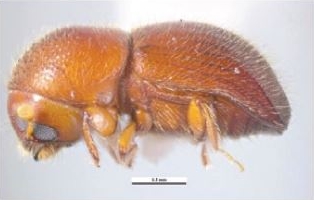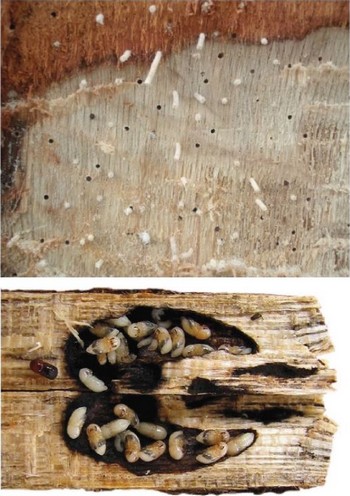PESTS AND DISEASES OF FORESTRY IN NEW ZEALAND
New ambrosia beetle found in Auckland
Scion is the leading provider of forest-related knowledge in New Zealand
Formerly known as the Forest Research Institute, Scion has been a leader in research relating to forest health for over 50 years. The Rotorua-based Crown Research Institute continues to provide science that will protect all forests from damage caused by insect pests, pathogens and weeds. The information presented below arises from these research activities.
From Forest Health News 288, May 2019.

Image: Pest and Diseases Image Library
In February 2019, specimens of the granulate ambrosia beetle (Xylosandrus crassiusculus) were identified from a sample collected in Blockhouse Bay, Auckland. Subsequent surveys and trapping has revealed the presence of the beetle at three other locations in Auckland (Kumeu, Riverhead, and Titirangi).
The granulate ambrosia beetle is native to East Asia. It has a reputation as an invasive species, being found in parts of Africa, the Americas, and Europe. Closer to home, it has also been found on several Pacific Islands, and recently in Queensland, Australia.

Bottom: Granulate ambrosia beetle gallery, with pupae and black fungus.
Images: Top: https://inaturalist.nz User: stephen-thorpe. Bottom: Hulcr, under CC3.0.
Ambrosia beetles live in symbiosis with ambrosia fungi. The beetle carries spores of the fungi between trees, excavating tunnels into the wood and infecting the tree, with the fungi acting as the beetle’s food source. The fungi penetrate the xylem tissues, which can impact tree health and even cause tree death. This beetle prefers damp fresh dead wood, but, unlike most ambrosia beetles, the granulate ambrosia beetle will also attack healthy trees.
The adult female beetles are 2-3 mm long and are thought to have 1-2 generations per year. The females leave the tree already mated, ready to start the next generation. Males are smaller and rarely seen, as they do not normally leave the host tree.
The granulate ambrosia beetle usually attacks small stems and branches, but can attack main trunks up to 30 cm diameter. Seedlings can also be attacked.
This beetle has a wide host range and is known from over 100 species across at least 40 plant families. It has already been detected in native broadleaf species. Economically relevant host species include avocado, plum and peach. Hosts of relevance to forestry are species of Eucalyptus and Acacia. Conifers in general, including Pinus radiata, are not known hosts. The beetle can also attack stored hardwood timber.
An infestation of the beetle has a tell-tale sign; ‘toothpicks’ or ‘noodles’ of compacted frass pushed out of the tree. These are quite distinctive but any holes without frass may be confused with those produced by native Platypus spp. Sap bleeding may also be observed.
If you think you have found this beetle, please ring the Biosecurity New Zealand Exotic Pest and Disease Hotline, 0800 80 99 66.
Andrew Pugh, Scion
This information is intended for general interest only. It is not intended to be a substitute for specific specialist advice on any matter and should not be relied on for that purpose. Scion will not be liable for any direct, indirect, incidental, special, consequential or exemplary damages, loss of profits, or any other intangible losses that result from using the information provided on this site.
(Scion is the trading name of the New Zealand Forest Research Institute Limited.)

 Farm Forestry New Zealand
Farm Forestry New Zealand

